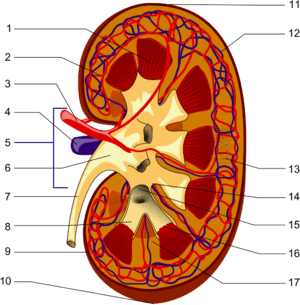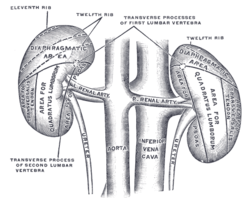Renal artery
| Renal artery | |
|---|---|
 Renal arteries branching left and right from the aorta (in red) | |

| |
| Details | |
| Source | Abdominal aorta |
| Branches | Inferior suprarenal artery, segmental arteries |
| Vein | Renal vein |
| Supplies | Kidneys |
| Identifiers | |
| Latin | Arteria renalis |
| MeSH | A07.231.114.745 |
| TA | A12.2.12.075 |
| FMA | 14751 |
The renal arteries normally arise off the side of the abdominal aorta, immediately below the superior mesenteric artery, and supply the kidneys with blood. Each is directed across the crus of the diaphragm, so as to form nearly a right angle with the aorta.
The renal arteries carry a large portion of total blood flow to the kidneys. Up to a third of total cardiac output can pass through the renal arteries to be filtered by the kidneys.
Structure
It has a radius of approximately 0.25 cm,[1] 0.26 cm at the root.[2] The measured mean diameter can differ depending on the imaging method used. For example, the diameter was found to be 5.04 ± 0.74 mm using ultrasound, but 5.68 ± 1.19 mm using angiography.[3][4]
Due to the position of the aorta, the inferior vena cava, and the kidneys in the body, the right renal artery is normally longer than the left renal artery.[5][6]
- The right passes behind the inferior vena cava, the right renal vein, the head of the pancreas, and the descending part of the duodenum.
- The right is somewhat lower than the left; left artery lies behind the left renal vein, the body of the pancreas and the splenic vein, and is crossed by the inferior mesenteric vein.
Branches
Before reaching the hilus of the kidney, each artery divides into four or five branches; the greater number of these (anterior branches) lie between the renal vein and ureter, the vein being in front, the ureter behind, but one or more branches (posterior branches) are usually situated behind the ureter.
Each vessel gives off some small inferior suprarenal branches to the suprarenal gland, the ureter, and the surrounding cellular tissue and muscles.
One or two accessory renal arteries are frequently found, especially on the left side since they usually arise from the aorta, and may come off above (more common) or below the main artery. Instead of entering the kidney at the hilus, they usually pierce the upper or lower part of the organ.
Variation
The arterial supply of the kidneys is variable and there may be one or more renal arteries supplying each kidney. It is located above the renal vein. Supernumerary renal arteries (two or more arteries to a single kidney) are the most common renovascular anomaly, occurrence ranging from 25% to 40% of kidneys.
Clinical significance
Renal artery stenosis, or narrowing of one or both renal arteries will lead to hypertension as the affected kidneys release renin to increase blood pressure to preserve perfusion to the kidneys. RAS is typically diagnosed with duplex ultrasonography of the renal arteries. It is treated with the use of balloon angioplasty and stents, if necessary.
Atherosclerosis can also affect the renal arteries and can lead to poor perfusion of the kidneys leading to reduced kidney function and, possibly, renal failure.
Additional images
 The posterior surfaces of the kidneys, showing areas of relation to the parietes.
The posterior surfaces of the kidneys, showing areas of relation to the parietes.- Renal artery
- Renal artery
- Renal artery
- Renal artery
References
- ↑ Kem, D. C.; Lyons, D. F.; Wenzl, J.; Halverstadt, D.; Yu, X. (2005). "Renin-Dependent Hypertension Caused by Nonfocal Stenotic Aberrant Renal Arteries: Proof of a New Syndrome". Hypertension. 46 (2): 380–5. doi:10.1161/01.HYP.0000171185.25749.5b. PMID 15967872.
- ↑ Ottesen, Johnny T.; Danielsen, Michael, eds. (2000). Mathematical Modelling in Medicine. IOS Press. ISBN 978-4-274-90318-2.
- ↑ Renal Artery Aneurysm at eMedicine
- ↑ Aytac, Suat K.; Yigit, Hasan; Sancak, Tanzer; Ozcan, Hasan (2003). "Correlation between the diameter of the main renal artery and the presence of an accessory renal artery: sonographic and angiographic evaluation". Journal of Ultrasound in Medicine. 22 (5): 433–9; quiz 440–2. PMID 12751854.
- ↑ Saldarriaga, Bladimir; Pinto, Sergio A; Ballesteros, Luis E (2008). "Morphological Expression of the Renal Artery: A Direct Anatomical Study in a Colombian Half-caste Population". International Journal of Morphology. 26 (1): 31–8. doi:10.4067/S0717-95022008000100005.
- ↑ http://www.anatomyatlases.org/AnatomicVariants/Cardiovascular/Text/Arteries/Renal.shtml[]
External links
- MedlinePlus Image 9818
- Anatomy photo:40:11-0105 at the SUNY Downstate Medical Center - "Posterior Abdominal Wall: Branches of the Abdominal Aorta"